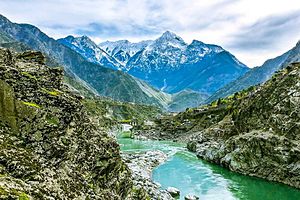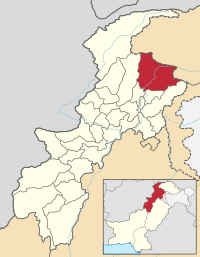Kohistan District, Pakistan
Kohistan District, also known as Indus Kohistan (Kohistani: سندھُ کوستَیں)[2][3] and Hazara Kohistan,[4] was a District within the Hazara Division of Khyber Pakhtunkhwa, Pakistan. Consisting of eastern portion of the larger Kohistan region, it was bifurcated into two districts in 2014: Upper Kohistan and Lower Kohistan. In 2017, the Lower Kohistan District was further bifurcated and a district Kolai-Palas was established.[5][6] It has an area of 7,492 square kilometres (2,893 sq mi) and a population of 472,570 according to the 1998 Census.[7]
Indus Kohistan
کوہستان | |
|---|---|
 | |
 Location of the former Kohistan District (highlighted in red) in Pakistan | |
| Coordinates: 35°15′N 73°30′E / 35.250°N 73.500°E | |
| Country | Pakistan |
| Province | Khyber Pakhtunkhwa |
| Division | Hazara |
| Established | 1 October 1976-2014 |
| Headquarters | Dasu |
| Area | |
• Total | 7,492 km2 (2,893 sq mi) |
| Population (2017)[1] | |
• Total | 784,711 |
| • Density | 100/km2 (270/sq mi) |
| Time zone | UTC+5 (PST) |
Geographically, Kohistan stretched from Gilgit-Baltistan in the north to the Mansehra District in the east to the Battagram District and Shangla and Swat districts in the west.[8]
Geography
editThe district lies between 34° 54′ and 35° 52′ north latitudes and 72° 43′ and 73° 57′ east longitudes.[8] It was bounded by the Diamer District of Gilgit-Baltistan in the north, Manshera District in the southeast, Kaghan Valley of the Mansehra District in the southeast , Battagram District in the south and Shangla and Swat Districts in the west .[8]
Kohistan is the point of convergence for the Hindukush, Karakorum, and Himalayan mountain ranges, acting as a natural boundary delineating distinct environmental regions within the expanse of the Himalayas, Karakoram, and Hindu Kush mountain chains.[8] This uniqueness of the mountain system also results in rich flora and fauna, thus providing a habitat for unique species such as the Western Tragopan pheasant and the snow leopard.[8]
Education
editThe literacy rate of the district among the population aged 10 years and older is 11.1%: male 17.23% and female 2.95%. The proportion of the working or employed population to the population aged 10 years and older is 26.47%, which is 70.53% of the total labour force. Out of the total employed population, 71.60% are self-employed, 10.68% work as employees, and 17.32% are unpaid family helpers.[citation needed]
Kohistan's literacy rate is among the lowest in Pakistan and hovers around 20%.[9] It has the lowest Human Development Index of all districts in Khyber Pakhtunkhwa.
Demographics
edit| Year | Pop. | ±% p.a. |
|---|---|---|
| 1951 | 18,775 | — |
| 1961 | 54,452 | +11.24% |
| 1972 | 84,826 | +4.11% |
| 1981 | 147,635 | +6.35% |
| 1998 | 280,666 | +3.85% |
| 2017 | 784,711 | +5.56% |
| Sources:[10] | ||
At the time of the 2017 census the district had a population of 784,711, of which 424,643 were males and 360,055 females. The rural population was 706,433 (97.95%) while the urban population was 72,654 (2.05%). The literacy rate was 76.20% - the male literacy rate was 86.40% while the female literacy rate was 65.76%. 3,172 (0.24%) people in the district were from religious minorities, mainly Christians.[11]
At the time of the 2017 census, 91.96 of the population spoke Kohistani, 7.09% Pashto, 0.36% Urdu and 0.63% Punjabi as their first language. 2.07% of the population spoke languages classified as 'Others', mainly Kohistani languages.[11]
The major language of the area is Kohistani, which in the 1981 census, was the mother tongue of 92% of households.[12] The variety spoken in the District of Kohistan has formed the basis of a literary language.[13] It is very close to the Dardic Language of Kohistan: the two share 86% of their basic vocabulary.[14]
Other languages, such as Pashto, Urdu and Punjabi, are found more in urban than rural areas.
See also
editReferences
edit- ^ "DISTRICT WISE CENSUS RESULTS CENSUS 2017" (PDF). www.pbscensus.gov.pk. Archived from the original (PDF) on 29 August 2017.
- ^ Frembgen, Jürgen Wasim (1999). "Indus Kohistan An Historical and Ethnographie Outline". Central Asiatic Journal. 43 (1): 70–98. ISSN 0008-9192. JSTOR 41928174.
- ^ Karandashev, Victor (24 December 2016). Romantic Love in Cultural Contexts. Springer. p. 189. ISBN 978-3-319-42683-9.
- ^ "Kohistan Valley". Vertical Explorers. 8 May 2019. Retrieved 5 September 2024.
- ^ Report, Bureau (16 January 2014). "KP govt creates new Kohistan district". DAWN.COM.
{{cite web}}:|first=has generic name (help) - ^ "Kolai-Palas notified as new district". www.thenews.com.pk. 26 August 2017.
- ^ "Brochure of District Kohistan NWFP" (PDF). 1998.
- ^ a b c d e Kanga, Shruti; Singh, Suraj Kumar; Meraj, Gowhar; Farooq, Majid (15 February 2022). Geospatial Modeling for Environmental Management: Case Studies from South Asia. CRC Press. p. 287. ISBN 978-1-000-53920-2.
- ^ "Literacy-Population 10 Years and Older" (PDF). Archived from the original (PDF) on 13 November 2010. Retrieved 28 September 2010.
- ^ "Population by administrative units 1951-1998" (PDF). Pakistan Bureau of Statistics.
- ^ a b "District Wise Results / Tables (Census - 2017)". www.pbscensus.gov.pk. Pakistan Bureau of Statistics.
- ^ 1981 District Census report of Kohistan. District Census Report. Vol. 24. Islamabad: Population Census Organization, Statistics Division, Government of Pakistan. 1983. p. 78. The data is specifically for kohistan District.
- ^ Rahman, Tariq (1996). Language and politics in Pakistan. Oxford University Press. pp. 211–14. ISBN 978-0-19-577692-8.
- ^
The figure is from:
- Lothers, Michael; Lothers, Laura (2010). Pahari and Pothwari: a sociolinguistic survey (Report). SIL Electronic Survey Reports. Vol. 2010–012. p. 24.
- Rensch, Calvin R. (1992). "The Language Environment of Hindko-Speaking People". In O'Leary, Clare F.; Rensch, Calvin R.; Hallberg, Calinda E. (eds.). Hindko and Gujari. Sociolinguistic Survey of Northern Pakistan. Islamabad: National Institute of Pakistan Studies, Quaid-i-Azam University and Summer Institute of Linguistics. p. 56. ISBN 969-8023-13-5.